Connected Living Room Market Research, 2032
The global connected living room market was valued at $47.3 billion in 2022 and is projected to reach $98.4 billion by 2032, growing at a CAGR of 7.8% from 2023 to 2032.
A connected living room is a concept used to describe the use of technology in a household in which all major gadgets are connected to the internet. This comprises consumer electronics commonly found in the living room, such as televisions, gaming consoles, or radios, that are connected to the internet either directly or via a wireless router.
There are various advantages to having a connected living room. For instance, it gives more control over things such as energy savings, security, and convenience. Secondly, it provides a simple and efficient method of disseminating timely information and encouraging resident interaction in senior living facilities. Thirdly, it promotes market innovation by increasing the availability of connected products such as smart televisions, smart speakers, gaming consoles, and set-top boxes, among others. Fourthly, it allows the growth in popularity of online media streaming, which is expected to drive the adoption of linked living rooms, and finally, it enables the integration of all key household gadgets that are internet-connected, such as smartphones, tablets, laptops, and game consoles. Examples of connected living room devices are smartphones, tablets, laptops, TVs, set-top boxes, DVRs, home theatre systems, computer modems, equipment for enabling Wi-Fi, Bluetooth, and infrared networks, and network interface cards, smart TVs, lighting, security alarms, doorbells, and cleaning appliances.
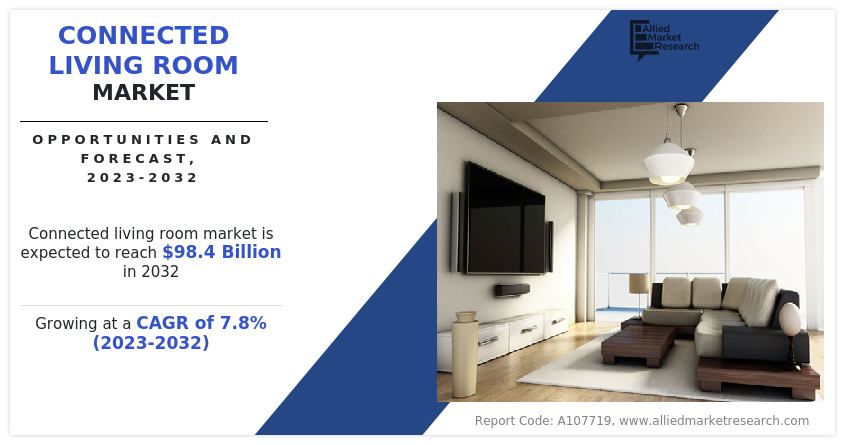
One of the important drivers of the connected living room market is the rise in popularity of online media streaming across the globe. Many people have shifted from traditional cable or satellite TV towards on-demand streaming alternatives such as Netflix and Disney+. This trend has increased demand for smart TVs, media streaming devices, and home theatre systems. For instance, devices such as the Amazon Fire TV Stick, Roku, and Apple TV, connect to the internet and allow customers to stream video directly to their TVs. This shift has transformed the living room into a linked entertainment hub, resulting in growth in the market for connected living room solutions. Moreover, a connected living room market growth can improve home security by enabling the integration of smart locks, which makes it easy to open and monitor the front door with a smartphone from anywhere. In addition, home automation, which is a key component of a connected living room, is expected to be considered as a means of gaining larger control over aspects such as security.
For instance, the COVID-19 pandemic has positively impacted the growth of OTT subscriptions. The global subscription growth rate for OTT video streaming companies grew 7x in March 2020, as compared to the growth rate over the previous 12 months The over-the-top sector in India saw an increase of 30 percent in paid subscriptions between January and July 2020, from over 21 million to 29 million. COVID-19 accelerates free trials and new subscription growth in digital media and entertainment, education, software, and consumer goods.
Furthermore, the proliferation of smartphones and tablets drives the growth of the connected living room market by establishing a smooth and convenient ecosystem for entertainment consumption. Consumers may now access and operate their linked living room gadgets from the palm of their hands with the growth in the use of smartphones and tablets. This connection enables customers to stream content, operate smart TVs, adjust lighting, and even manage smart home devices all from a single smartphone. For instance, many smart TVs come with accompanying apps that allow users to navigate menus, search for content, and control settings directly from their smartphones or tablets.
The rise of voice-controlled devices and virtual assistants is another important driver for the connected living room market growth. Users may now control their entertainment devices and access content with simple voice commands, providing convenience and ease of use with the rise of voice-controlled devices and virtual assistants. This has resulted in greater adoption of linked living room technologies, with smart TVs and media streaming devices incorporating voice control functions and linking with voice-enabled gadgets. The seamless integration of voice control has altered the way customers engage with their entertainment systems, propelling the rise of the connected living room market. For instance, smart TVs and media streaming devices now come equipped with built-in voice control features or can be easily connected to voice-enabled devices, allowing users to interact with their entertainment systems effortlessly.
On the other hand, high deployment costs hinder the growth of the market as they pose a significant barrier to entry for many consumers. For some households, the cost of purchasing and configuring connected gadgets such as smart TVs, video streaming devices, and home automation systems might be too expensive and, the requirement for consistent and high-speed internet connectivity is also costly the initial investment and continuous maintenance expenses may prevent potential customers from embracing connected living room devices. Furthermore, the complexity of installation and setup may be a disincentive for users who are not tech-savvy or lack the requisite technical knowledge. For example, the cost of purchasing a smart TV, media streaming device, and home automation system may be expensive, and the need for reliable internet connectivity adds to the expenses. The complexity of installation and setup may also be a deterrent for consumers.
Separately, the increase in the adoption of smart TVs presents a significant future opportunity for the connected living room industry in the coming year. Smart devices, such as smartphones, tablets, and other connected devices are used in living rooms. Smart TVs include built-in internet connectivity, which allows customers to access streaming services, browse the web, and download apps right from their television screens. This combination of internet capabilities and traditional television functionality makes a living room hub for linked entertainment. Opportunities for the spread of connected living room technology open as smart TV penetration grows. To improve the user experience, manufacturers can create and implement unique features such as voice control, seamless connection with other smart devices, and personalized content recommendations. Furthermore, the increase in demand for 4K and HDR content boosts the desire for advanced smart TV models with enhanced connectivity possibilities. For example, the webOS of the LG platform provides a user-friendly interface and voice control via LG ThinQ and Google Assistant. Tizen OS of Samsung connects seamlessly with other smart devices via SmartThings, allowing customers to control their connected home appliances from the comfort of their living room. These improvements in smart TV technology create an ecosystem in the living room that encourages the adoption of other connected devices such as smart speakers, video streaming devices, and home automation systems, thereby creating an opportunity for the connected living room industry.
Segment Overview
The connected living room market outlook is segmented into Product Type, Application, and Component.
Based on product type, the connected living room market size is divided into smart TVs, gaming consoles, computers and laptops, smart speakers, smartphones and tablets, security systems, and lighting systems. In 2022, the smartphone and tablets segment dominated the connected living room market share, in terms of revenue, and smart TVs are expected to acquire the highest CAGR from 2023 -2032.
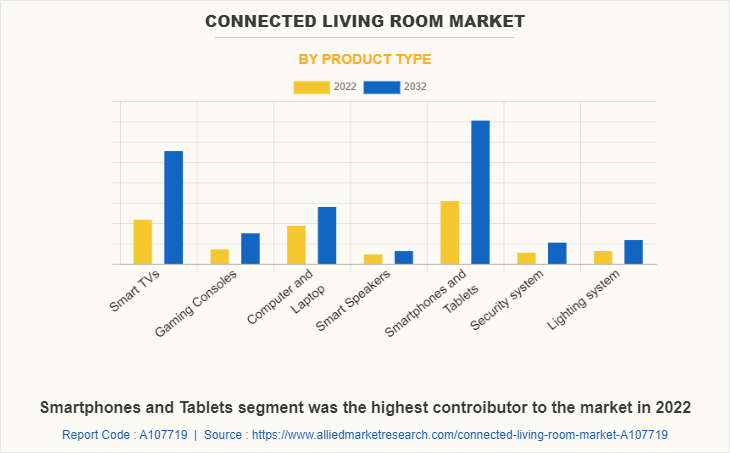
On the basis of application, the connected living room market size is categorized into video streaming, audio streaming, gaming, and security. The video streaming segment will dominate the connected living room market share during 2023 - 2032.
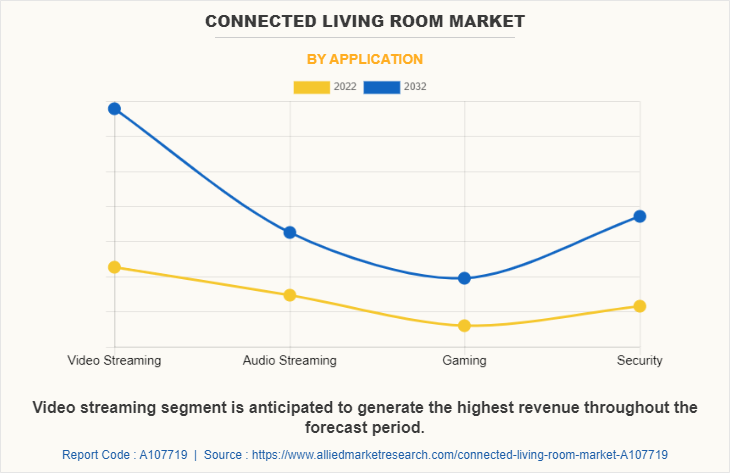
Based on components, the connected living room market forecast is segmented into sensors, thermostats, cameras, communication devices, and others. The camera segment will dominate the market during 2023 - 2032.
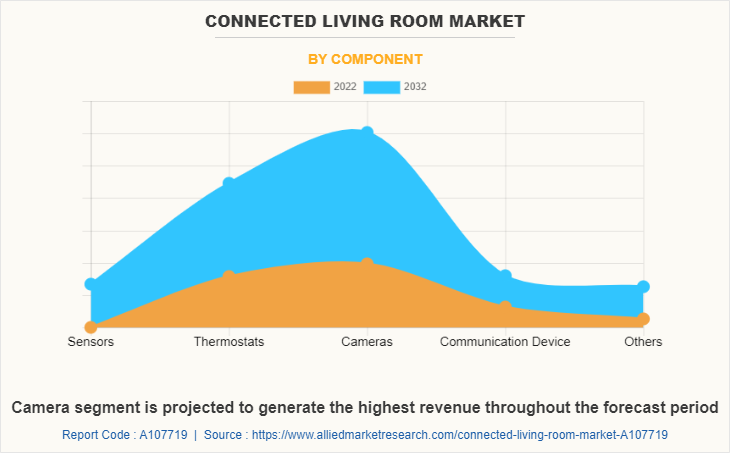
Region-wise, the connected living room market trends are analyzed across North America (the U.S., Canada, and Mexico), Europe (UK, Germany, France, and the rest of Europe), Asia-Pacific (China, Japan, India, South Korea, and rest of Asia-Pacific), and LAMEA (Latin America, Middle East, and Africa). Asia-Pacific region would exhibit the highest CAGR of 8.87% during 2023-2032.
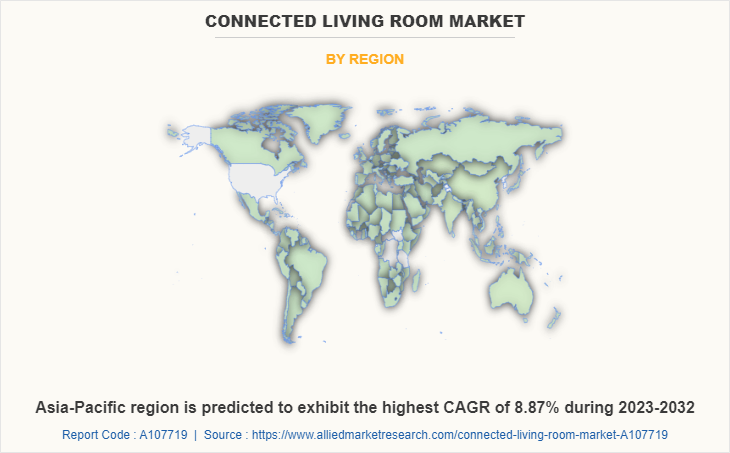
Top Impacting Factors
The market for connected living room market demand is anticipated to expand significantly during the forecast period owing to the rising popularity of online media streaming. In addition, the rise of voice-controlled devices and virtual assistants of connected living room devices fuels the market growth. In addition, the connected living room is anticipated to benefit owing to the increase in the adoption of smart TVs and is expected to present enormous opportunities for the market over the forecast period. On the other hand, High deployment costs are anticipated to restrain the market growth during the forecast period.
Competitive Analysis
The key players profiled in the connected living room market, such as LG Electronics Inc., Roku Inc., Google Inc., Apple Inc., Amazon Inc., Samsung Corporation, Honeywell International Inc., Panasonic Corporation, Toshiba Corporation, and Signify Holding are provided in this report. Market players have adopted various strategies such as product launches, and acquisitions, to expand their foothold in the connected living room market.
Historical Data & Information
The connected living room market is highly competitive, owing to the strong presence of existing vendors. Vendors in the connected living room market with extensive technical and financial resources are expected to gain a competitive advantage over their competitors as they can cater to market demands. The competitive environment in this market is expected to increase owing to technological innovations, product extensions, and different strategies adopted by key vendors.
Key Developments/ Strategies
LG Electronics Inc., Roku Inc., Google Inc., Apple Inc., Amazon Inc, Samsung Corporation, Honeywell International Inc., Panasonic Corporation, Toshiba Corporation, and Signify Holding are the top companies holding a prime share in the global connected living room market. Top market players have adopted various strategies, such as expansion and investment to expand their foothold in the aeroponics market.
- In March 2023, Apple launched a new yellow iPhone 14 and iPhone 14 Plus, adding even more color choices to the lineup. Beautifully designed and built to last, the iPhone 14 and iPhone 14 Plus have a durable Ceramic Shield front cover, an updated internal design for better-sustained performance and easier repairs, and amazing battery life with the iPhone 14 Plus offering the longest battery life of any iPhone ever. Both the models include a dual camera system for stunning photos and videos, the powerful A15 Bionic chip, and innovative safety capabilities including Emergency SOS via satellite and Crash Detection.
- In October 2022, Apple unveiled Apple TV 4K’s next generation, which is more entertaining, affordable, and powerful. The Apple TV 4K is powered by the A15 Bionic chip, which provides improved fluid gameplay and faster performance. The TV offers magnificent cinematic quality and multiple entertainment choices.
- In August 2021, signify launched the Philips LED A-class bulb, which consumes 60% less energy than a standard Philips LED.
Key Benefits For Stakeholders
- This report provides a quantitative analysis of the market segments, current trends, estimations, and dynamics of the connected living room market analysis from 2022 to 2032 to identify the prevailing connected living room market opportunity.
- The market research is offered along with information related to key drivers, restraints, and opportunities.
- Porter's five forces analysis highlights the potency of buyers and suppliers to enable stakeholders to make profit-oriented business decisions and strengthen their supplier-buyer network.
- An in-depth analysis of the connected living room market segmentation assists in determining the prevailing market opportunities.
- Major countries in each region are mapped according to their revenue contribution to the global market.
- Market player positioning facilitates benchmarking and provides a clear understanding of the present position of the market players.
- The report includes an analysis of the regional as well as global connected living room market trends, key players, market segments, application areas, and market growth strategies.
Connected Living Room Market Report Highlights
| Aspects | Details |
| Market Size By 2032 | USD 98.4 billion |
| Growth Rate | CAGR of 7.8% |
| Forecast period | 2022 - 2032 |
| Report Pages | 303 |
| By Product Type |
|
| By Application |
|
| By Component |
|
| By Region |
|
| Key Market Players | Apple Inc., Roku, Inc., Amazon.com, Inc., LG Electronics Inc., Signify Holding, Panasonic Holdings Corporation, Toshiba Corporation, Google LLC, SAMSUNG ELECTRONICS CO., LTD., Honeywell International Inc. |
Analyst Review
The global connected living room market holds high potential for the semiconductor industry. The business scenario witnesses an increase in the demand for connected living room devices, particularly in developing regions, such as China, India, the U.S., the UK, and others. Companies in this industry have been adopting various innovative techniques to provide customers with advanced and innovative product offerings.
The rise in popularity of online media streaming, and the rise of voice-controlled devices and virtual assistants of connected living room drive this market. However, high deployment costs impede this growth. During the forecast period it is anticipated to witness an increase in adoption of smart TVs is expected to create lucrative opportunities for the key players operating in this market.
The market participants are expected to introduce technologically advanced products to remain competitive in the market. Product launch and collaboration are the prominent strategies adopted by the market players.
Smart TVs and streaming devices, voice-controlled home entertainment, connected gaming consoles, and others are the upcoming trends of connected living room market in the world.
Smart TVs, video streaming devices, audio Streaming and others are the leading application of connected living room market.
Asia-Pacific is the largest regional market for connected living room.
USD 98.43 billion is the estimated industry size of the connected living room market.
LG Electronics Inc., Roku Inc., Google Inc., Apple Inc., Amazon Inc, Samsung Corporation, Honeywell International Inc., Panasonic Corporation, Toshiba Corporation, and Signify Holding are the top companies holding the market share in the connected living room market.
Loading Table Of Content...
Loading Research Methodology...


